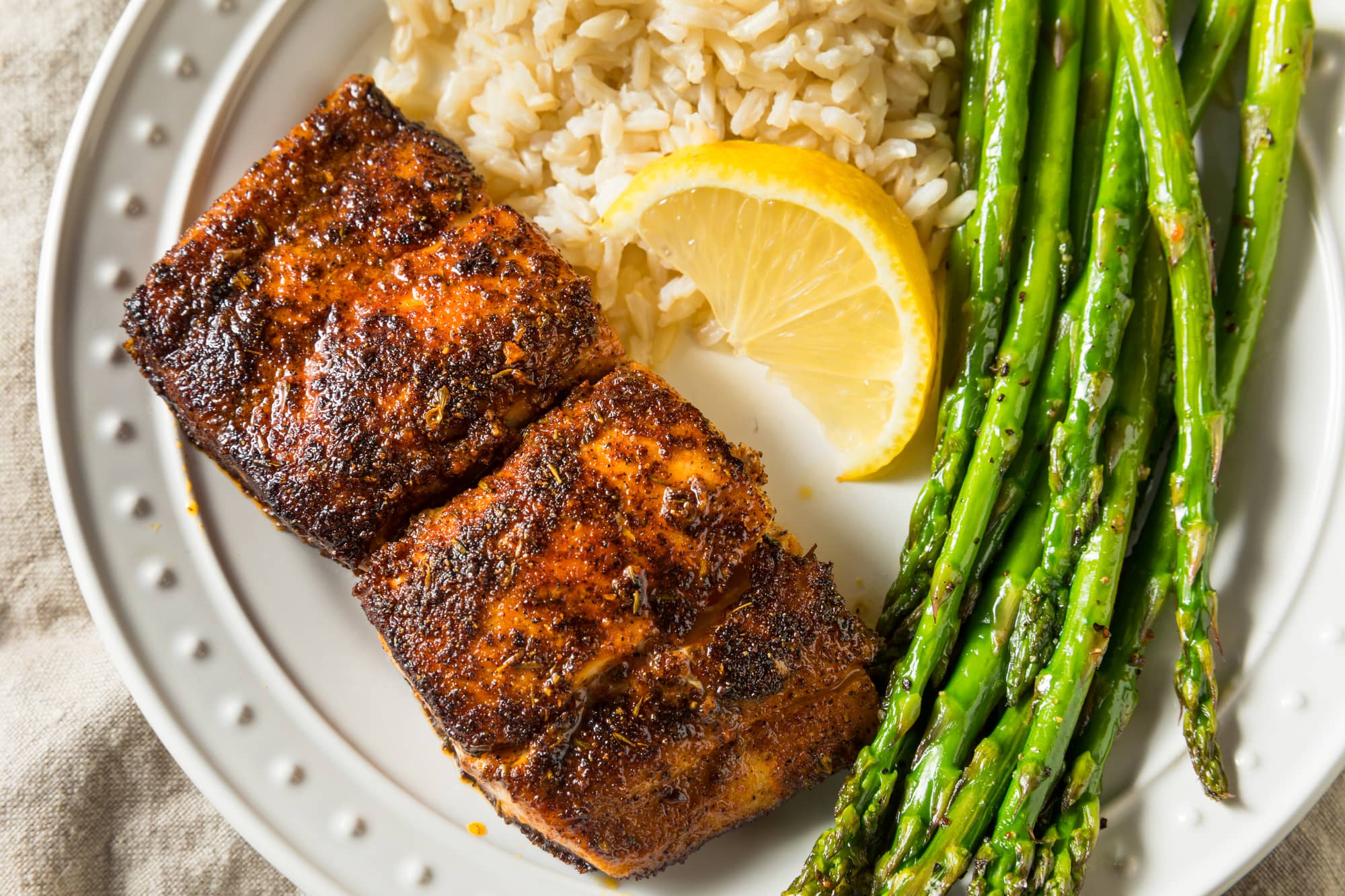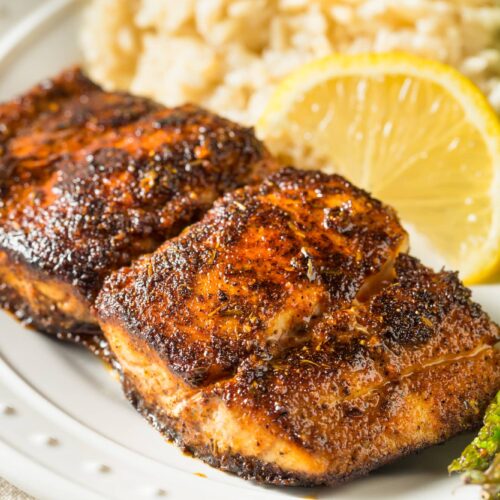
If you’re looking to upgrade your seafood game, grilled Mahi Mahi is an excellent choice. If it’s your first time hearing about it, it’s actually a versatile fish that’s easy to prepare and is enjoyed by even the most discerning tastes. So in this article, we’ll talk about Mahi Mahi from buying and preparing it to grilling it to perfection. Let’s begin!
What Is Mahi Mahi?
Mahi-mahi is a type of fish known for its vibrant colors and delicious taste. It is also called dolphinfish, though it’s not related to dolphins. “Mahi Mahi” comes from the Hawaiian language that literally means “strong-strong.” This is because of the fish’s firm flesh that’s well-known for its sweetness and versatility, though many prefer it grilled.
Buying Guide for the Mahi Mahi

Like any other fish, freshness is key. To help you get the best quality, you can follow these tips:
Follow the Color: Fresh Mahi Mahi will be vibrantly colored with a deep pink or reddish hue. If the fish looks dull or has a grayish tint, it’s better to skip it and buy somewhere else.
Test the Scent: Fresh fish has a mild ocean smell but not overly fishy. It shouldn’t smell sour or pungent in any way. If it is, you’re better off looking elsewhere.
Check for Firmness: Sellers who are confident in their products will allow you to gently press the flesh with your finger, not grab. Observe if it bounces back quickly. Check if your touch leaves an indentation, since lingering indentation means the flesh is starting to get mushy inside.
Watch the Skin and Scales: If you’re buying the fish whole, make sure the skin is shiny and the scales are intact and not falling off. If you’re buying filets, each piece should have a clean, smooth surface with good color, smell, and tenderness.
How to Clean & Filet
Cleaning and fileting Mahi Mahi is straightforward, but a little practice makes perfect:
Scaling the Fish: Get a fish scaler or use the back of a knife to scrape off the scales, moving from the tail to the head. Apply firm pressure and use a clean towel to hold down the fish while you remove the scales.
Gut the Fish: Make a cut from the anus up to the gills using a sharp knife to open the belly. Gently remove the internal organs and avoid the bile sac (it’s round and yellowish green) because if it gets punctured, it can leave a bitter taste to the flesh. Rinse the empty cavity with cold water to ensure it’s clean.
Filet the Fish: Place the fish on a cutting board and make a cut behind the gills down to the backbone, using a sharp knife. Angle the knife along the rib cage and gently separate the filet from the bones, then repeat on the other side for the second filet.
Remove the Skin: Lay the filet skin-side down on the cutting board and make a cut between the flesh and skin, holding the skin taut with your hand. Gently pull the skin away as you slice, ensuring you remove it cleanly and leave the flesh intact. If this is your first time, you might find it difficult to do. But there are now fish skinner tools you can buy to make the task easier.
How to Season
Here are some simple seasoning ideas you can use for your next cookout:
Classic Lemon Herb: A mixture of lemon juice, olive oil, garlic, salt, and pepper. If you enjoy herbs like parsley or dill, you can add some for extra freshness and to remove any fishy smell.
Spicy Cajun: Blend paprika, cayenne pepper, garlic powder, onion powder, and a touch of salt. This gives the fish a nice kick as well as a vibrant color that adds to the presentation.
Tropical Glaze: A combination of pineapple juice, soy sauce, ginger, and a hint of honey. This sweet and savory glaze pairs beautifully with the fish’s mild flavor.
Mediterranean Twist: Use olive oil, lemon zest, dried oregano, and a sprinkle of feta cheese for a Mediterranean flair.
Useful Cooking Tips
Mahi Mahi can be cooked several ways, so here are some tips you can use to ensure a delicious experience:
Preheat the Grill: A preheated grill guarantees a beautiful sear and keeps the fish from sticking. This technique is best used when cooking the fish whole.
Use a Grill Basket: If you’re cooking filets and are worried about the filets falling apart, a grill basket is the perfect tool to use. If you don’t have one, you can simply wrap the pieces in aluminum foil so it stays intact until it’s time to serve.
Marinate: Fresh fish seasoned with salt and pepper is all the flavor you need. But if you want to make it more special, you can marinate your Mahi Mahi for at least 30 minutes to enhance its flavor and keep it moist. Be mindful of the time especially if you’re using acids (vinegar, lime, lemon, etc.) because over marinating can start to cook the fish.
Watch the Cooking Time: Mahi Mahi cooks quickly, especially filets. It only takes about 4-5 minutes per side to cook, so keep an eye on it.
Simple Grilled Mahi Mahi Recipe
Ready to try grilling Mahi Mahi? Here’s a simple and delicious recipe to get you started.
Ingredients
- 4 Mahi Mahi filets (about 6 oz each)
- 2 tablespoons olive oil
- Juice of 1 lemon
- 3 cloves garlic, minced
- 1 teaspoon dried oregano
- 1 teaspoon paprika
- Salt and pepper to taste
Instructions
- In a small bowl, combine the olive oil, lemon juice, minced garlic, oregano, paprika, salt, and pepper. Mix well. Set aside some of the mixture for basting the fish.
- Place the Mahi Mahi filets in a shallow dish. Pour the marinade over the filets, making sure they are well coated. Cover and refrigerate for at least 30 minutes.
- Heat your grill to medium-high. Oil the grill grates or use a grill basket to prevent sticking.
- Place the filets on the grill. Cook for 4-5 minutes per side, or until the fish flakes easily with a fork.
- Remove from the grill and let the fish rest for a few minutes before serving.
Notes
Brush the filets with the marinade you set aside while grilling to retain moisture. Just make sure you don’t overdo it or you’ll end up with overly soft fish. You’ll know the fish is done once the internal temperature reaches 145°F (63°C).
What Sides Can Your Serve With Grilled Mahi Mahi?

Mahi Mahi can be served as a solo dish but you can make it extra special with delicious sides. Consider a crisp, citrusy salad with mixed greens, avocado, and a light vinaigrette to start. For a hearty option, serve it with fluffy white rice or quinoa, which will soak up any extra juices and add substance to your meal. Grilled vegetables like zucchini, bell peppers, and cherry tomatoes can also provide a colorful and healthy addition, while a tangy citrus salsa made with mango, pineapple, and lime offers a refreshing twist that enhances the fish’s delicate taste.
Conclusion
Grilled Mahi Mahi is not just delicious, it’s also a healthy and flavorful option for those who enjoy seafood. Whether you’re a seasoned cook or a beginner in the kitchen, this fish is easy to prepare and guaranteed to impress your guests. So fire up the grill and start your seafood feast today!

Simple Grilled Mahi Mahi
Ingredients
- 4 ~6oz each mahi mahi filets
- 2 tbsp olive oil
- juice of 1 lemon
- 3 cloves garlic, minced
- 1 tsp dried oregano
- 1 tsp paprika
- salt, to taste
- pepper, to taste
Instructions
- In a small bowl, combine the olive oil, lemon juice, minced garlic, oregano, paprika, salt, and pepper. Mix well. Set aside some of the mixture for basting the fish.
- Place the Mahi Mahi filets in a shallow dish. Pour the marinade over the filets, making sure they are well coated. Cover and refrigerate for at least 30 minutes.
- Heat your grill to medium-high. Oil the grill grates or use a grill basket to prevent sticking.
- Place the filets on the grill. Cook for 4-5 minutes per side, or until the fish flakes easily with a fork.
- Remove from the grill and let the fish rest for a few minutes before serving.

